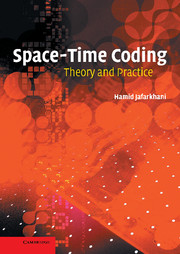Book contents
- Frontmatter
- Contents
- Preface
- Standard notation
- Space-time coding notation
- List of abbreviations
- 1 Introduction
- 2 Capacity of multiple-input multiple-output channels
- 3 Space-time code design criteria
- 4 Orthogonal space-time block codes
- 5 Quasi-orthogonal space-time block codes
- 6 Space-time trellis codes
- 7 Super-orthogonal space-time trellis codes
- 8 Differential space-time modulation
- 9 Spatial multiplexing and receiver design
- 10 Non-orthogonal space-time block codes
- 11 Additional topics in space-time coding
- References
- Index
11 - Additional topics in space-time coding
Published online by Cambridge University Press: 14 August 2009
- Frontmatter
- Contents
- Preface
- Standard notation
- Space-time coding notation
- List of abbreviations
- 1 Introduction
- 2 Capacity of multiple-input multiple-output channels
- 3 Space-time code design criteria
- 4 Orthogonal space-time block codes
- 5 Quasi-orthogonal space-time block codes
- 6 Space-time trellis codes
- 7 Super-orthogonal space-time trellis codes
- 8 Differential space-time modulation
- 9 Spatial multiplexing and receiver design
- 10 Non-orthogonal space-time block codes
- 11 Additional topics in space-time coding
- References
- Index
Summary
MIMO-OFDM
OFDM is an efficient technique for transmitting data over frequency selective channels. The main idea behind OFDM is to divide a broadband frequency channel into a few narrowband sub-channels. Then, each sub-channel is a flat fading channel despite the frequency selective nature of the broadband channel. To generate these parallel sub-carriers in OFDM, an inverse fast Fourier transform (IFFT) is applied to a block of L data symbols. To avoid ISI due to the channel delay spread, a few “cyclic prefix” (CP) symbols are inserted in the block. The cyclic prefix samples are also called guard intervals. Basically, the last g samples of the block are duplicated in front of the block as the cyclic prefix. The number of these cyclic prefix samples, g, should be bigger than the length of the channel impulse response. The effects of the cyclic prefix samples eliminate ISI and convert the convolution between the transmit symbols and the channel to a circular convolution. These cyclic pre-fix samples are removed at the receiver. Then, a fast Fourier transform (FFT) is utilized at the receiver to recover the block of L received symbols. Figure 11.1 shows the block diagram of a wireless communication system using OFDM over a SISO channel. In this section, we study how to use OFDM in a system designed for MIMO channels. This is usually called MIMO-OFDM.
- Type
- Chapter
- Information
- Space-Time CodingTheory and Practice, pp. 272 - 290Publisher: Cambridge University PressPrint publication year: 2005
- 1
- Cited by



